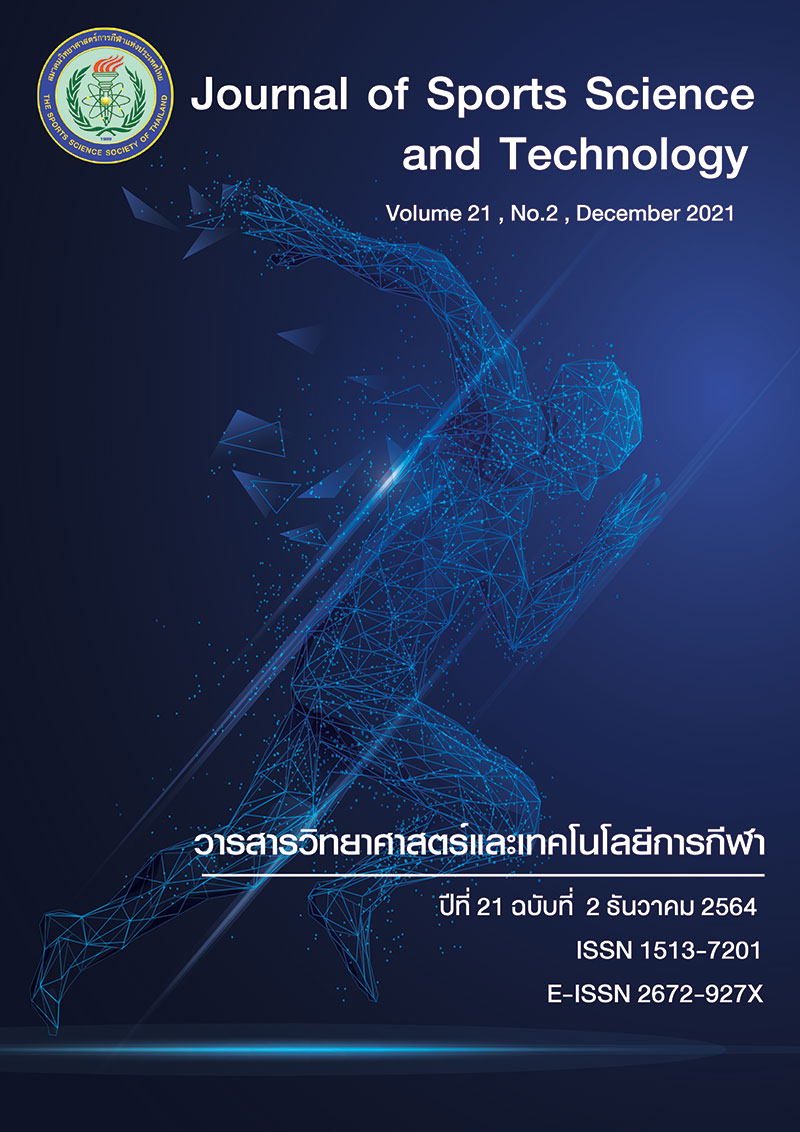EFFECTS OF PHYSICAL ACTIVITY ON STRESS AND PHYSICAL FITNESS IN NARESUAN UNIVERSITY STUDENTS, THAILAND
DOI:
https://doi.org/10.14456/jsst.2021.17Keywords:
Physical Activity, Stress, Heart Rate Variability, Physical Fitness, University StudentsAbstract
This research was a cross-sectional design which aim to study and compare the effects of high and moderate physical activity on stress and physical fitness in Naresuan university students. Thirty-six participants Naresuan university students, academic year 2020, participated this study. The participants were selected by purposive sampling. They were equally divided into 2 groups, the high and moderate physical activity (HA) group (n = 18) and sedentary (SE) group (n = 18). The variables were collected before midterm and final examination by using a stress assessment (SPST-20 test), heart rate variability (HRV), and physical fitness testing. The data were analyzed using ANOVA with repeated measures followed by LSD’s multiple comparison, Mann-Whitney U test, and Wilcoxon paired signed-rank test with level of significance .05
The results showed that the level of stress, both of before midterm and final examination, between HA and SE group were no significant difference at the .05 level. However, a level of stress in HA group was normal, while SE group had a high level of stress in both of before midterm and final examination. Notably, HRV in HA group were significantly greater (P<0.05) than SE group in the period of before midterm and final examination. Furthermore, physical fitness was greater (P<0.05) in HA group compared with SE group. In conclusion, university students with high and moderate physical activity had normal stress level though period of before midterm and final examination. The autonomic nervous system activity in HA group was improved, in favor of an increase the operation of parasympathetic activity as well as the improvement of physical fitness. Therefore, physical activity should be encouraged in all college students for decrease of stress and increase physical fitness.
(Journal of Sports Science and Technology 2021; 21 (2):141-155)
(Received: 9 August 2021 , Revised: 7 December 2021, Accepted: 8 December 2021 2021)
Keywords: Physical Activity/ Stress/ Heart Rate Variability/ Physical Fitness/ University Students *Corresponding author: Tussana JARUCHART Department of Physical Education and Exercise Science, Faculty of Education, Naresuan University, Phitsanulok, THAILAND
E-mail: tussanaj@nu.ac.th
References
preparation for university admission. Psychiatric Nurse Association of Thailand. 2017;31(2):78-94.
2. Khrukaew T, Chodpanich D, Disbunchong P, Wonganan P, Booran A, Kongsomboon K.
Type of exercise and stress in medical students at Srinakharinwirot university. SWU Medical Science.
2017:44-52.
3. Toda N, Nakanishi-Toda M. How mental stress affects endothelial function. Pflugers Arch. 2011;462:779-94.
4. Magwa S. Stress and adolescent development. GJER. 2013;3(8):373-80.
5. Radcliffe C, Lester H. Perceived stress undergraduate medical training. Med Educ. 2003;37:32-8.
6. Rayakeaw R, Satayasai W. 4-6th year medical students’ stress: case study at medical center,
Buddhachinaraj hospital, Phitsanulok. TMJ. 2013;13(1):17-23.
7. Habibzadeh N. The physiological impact of physical activity on psychological stress. Prog Health Sci.
2015;5(2):245-8.
8. Jaruchart T. Autonomic nervous system activity and heart rate variability in obesity. JSSH. 2020;21(2):177-
94.
9. Manimmanakorn N, Manimmanakorn A, Vichiansiri R, Saengsuwan J, Leelayuwat N. Heart rate variability
assessment and clinical uses. J Thai Rehabil Med. 2018;28(1):32-6.
10. Wheat AL, Larkin KT. Biofeedback of heart rate variability and related physiology: a critical review.
Appl Psychophysiol Biofeedback. 2010;35(3):229-42.
11. Suksom D. Exercise for health. First ed. Bangkok: Chulalongkorn University Press; 2018.
12. Department of mental health [Internet]. 2007 [updated 2007 Sep; cited 2021 Aug 7]. Available from
http://envocc.ddc.moph.go.th/uploads/%E0%B8%9B%E0%B8%A3%E0%B8%B0%E0%B8%8A%E0%
B8%B8%E0%B8%A1/20-21_11_61/C_4.pdf
13. Chudleigh C, Savage B, Cruz C, Lim M, McClure G, Palmer DM, et al. Use of respiratory rates and heart rate variability in the assessment and treatment of children and adolescents with functional somatic symptoms. Clin Child Psychol Psychiatry. 2019;24(1):29-39.
14. Department of physical education. Physical fitness test for people aged 19-59 years. Ministry of tourism
and sports 2019: 1-42.
15. Department of Health. Exercise for health. Ministry of Public Health 2012:1(1):1-8.
16. Nakayama N, Arakawa N, Ejiri H, Matsuda R, Makino T. Heart rate variability can clarify students’ level of stress during nursing simulation. PLoS ONE. 2018;13(4):1-12.
17. Kim HG, Cheon EJ, Bai DS, Lee YH, Koo BH. Stress and heart rate variability: a meta-analysis and review
of the literature. Psychiatry Investig. 2017;15(3):235-45.
18. Ren H, Song YE. Effects of physical exercises in varied intensities on mental health of college students.
Rev. Argentina de Clin. Psicol. 2020;29(2):1074-83.
19. Liu P, Yue N. Influence of physical exercise on mental health and anxiety of adolescents. Rev. Argentina
de Clin. 2020;29(2):249-55.
20. Mikkelsen K, Stojanovska L, Polenakovic M, Bosevski M, Apostolopoulos V. Exercise and mental health.
Maturitas. 2017;106:48-56.
21. Kritpet T. Exercise physiology. Bangkok: Tiranasar Co., Ltd; 2011.
22. Surachet K. The effect of aerobic dance exercise and bike exercise on maximal oxygen consumption. J
Sports Sci Technol. 2020;20(1):51-61.
23. Buaduang N, Sangtong N, Khongchawan K. Health-related physical fitness of year 1 students in Thaksin
university Songkhla campus. JSSRA. 2013;8(23):75-90.






